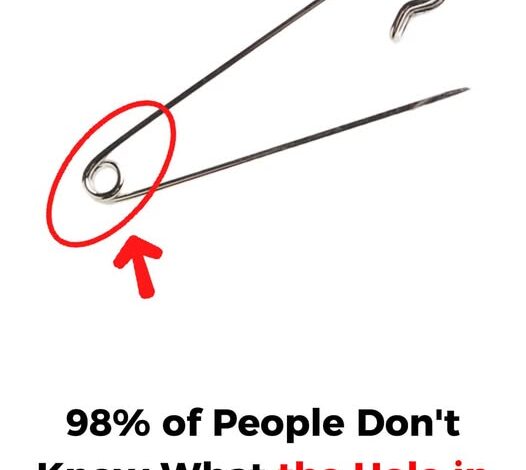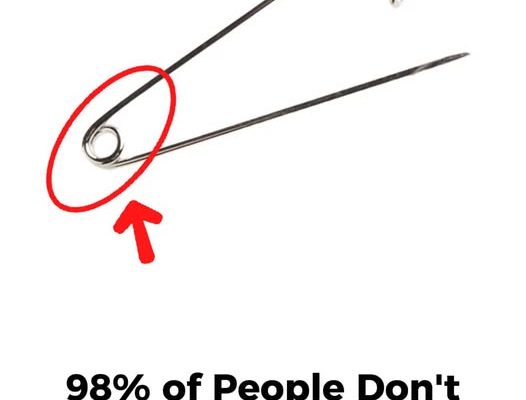
Safety pins are one of those household inventions so common that most people never stop to think about their design. Yet, hidden in plain sight is a tiny feature that makes them a masterclass in practical engineering: the small circular hole near the clasp. It’s easy to miss and even easier to dismiss as decorative, but that little opening serves several important—and surprisingly versatile—purposes that reveal the safety pin’s quiet brilliance.
Invented in 1849 by Walter Hunt, the safety pin was originally designed as a simple solution to fasten fabric and clothing without causing injury. Hunt sold his patent for just $400, unaware that his humble creation would outlive him by centuries. Over time, the basic design has changed very little, and for good reason: it’s nearly perfect. The coiled spring at one end provides tension, the clasp protects from pricks, and that mysterious hole near the clasp makes the whole mechanism far more effective and adaptable than most realize.
A Hidden Engineering Feature
That small hole isn’t there for decoration—it’s a stabilizer. When the pin is fastened to fabric, especially soft or slippery material, the hole can be used to secure a bit of thread or thin cord through it. This acts as an anchor, keeping the pin from twisting, slipping, or tearing the material. It’s a small feature with an outsized purpose: stability.
Anyone who’s ever used a safety pin on silk, satin, or a loose-knit sweater knows how easily the pin can rotate out of position. By threading a small piece of thread through the hole and securing it to the fabric, the user can lock the pin in place, ensuring it stays oriented exactly as intended. It’s a clever bit of functional foresight, allowing a simple piece of metal wire to behave with the precision of a tiny mechanical hinge.
Organization and Safety
The same hole also doubles as an organizational hack. Seamstresses, tailors, and crafters have long used it to thread multiple pins together on a thin string or piece of wire. This keeps pins grouped neatly and reduces the risk of losing them—or worse, stepping on one. It turns a handful of tiny, sharp tools into a tidy, manageable bundle.
In practical use, this simple feature can prevent accidents in busy workshops or sewing rooms. It’s an elegant example of low-tech safety design, showing how a single small modification can make a big difference in day-to-day handling.
Beyond the Sewing Kit
Outside of sewing, the hole also transforms the humble safety pin into a surprisingly versatile survival tool. In emergency situations—whether camping, hiking, or improvising repairs—the small hole provides an easy attachment point for a string, keychain, or lanyard. This lets you tether the pin to a backpack, belt loop, or zipper pull, keeping it handy for when you need to fix a torn strap, secure a bandage, or improvise a fishing hook.
Outdoor enthusiasts sometimes use the hole to attach safety pins to gear for quick access. In survival kits, the pin’s ability to clip onto fabric or hang from a cord makes it invaluable for fast repairs or makeshift fastening. The small hole is key to that flexibility—it’s what allows the pin to be both a tool and an accessory, ready for use in any setting.
The Physics Behind the Perfection
On a structural level, the hole also serves a secondary mechanical function: it slightly relieves stress at the clasp, distributing tension more evenly along the metal and preventing fatigue at a single point. This subtle reinforcement is part of what makes safety pins so reliable even after hundreds of uses.
The design balances simplicity with efficiency—a hallmark of timeless engineering. Unlike modern gadgets that rely on electronics or complex parts, the safety pin works because every curve and opening is intentional. Each component, including that small hole, contributes to both function and durability.
A Lesson in Design Minimalism
Modern industrial designers often cite the safety pin as a perfect example of minimalist design—an object that achieves multiple purposes with a single, seamless form. It does not rely on fancy materials or high-tech manufacturing. Instead, it demonstrates how good design anticipates problems before they occur: keeping users safe, organized, and efficient without them even realizing why.
This design philosophy extends far beyond sewing kits. Engineers, architects, and product designers often study the safety pin as an example of how elegance emerges from necessity. The tiny hole near the clasp is not an afterthought; it’s an intentional refinement born from experience, showing that even the smallest detail can transform usability.
Everyday Ingenuity
If you’ve ever found yourself improvising a fix on the fly—hemming a skirt in a restroom, reattaching a name tag, or holding together a broken strap—you’ve benefited from that same ingenuity. The pin’s hole lets you thread or tether it for precision work or quick access, proving its worth as one of the most universal tools ever created.
It’s also worth noting how cross-functional it has become in daily life. People have used safety pins as zipper pulls, temporary jewelry, makeshift fishing gear, or even emergency first-aid clamps. The tiny hole, inconspicuous though it is, plays a role in many of these adaptations—allowing the pin to be secured, suspended, or linked to other tools.
From Function to Symbol
Over the decades, the safety pin has evolved beyond its utilitarian roots. It has become a global symbol of solidarity and protection—worn on clothing as a quiet statement of empathy or protest. From punk fashion to social movements, it has carried meanings far beyond fabric fastening.
Even in those symbolic uses, the design’s practicality remains central. The hole allows wearers to attach it securely, ensuring it doesn’t spin or tear delicate fabric. The function and symbolism are inseparable—each reflecting simplicity, strength, and readiness.
The Takeaway
The safety pin’s genius lies not in complexity, but in restraint. Every curve and coil has a purpose, and that tiny hole—so easy to overlook—represents the mindset of true engineering: nothing added without reason, nothing missing that’s essential.
So next time you reach for one, take a second look. That small perforation near the clasp isn’t just a design quirk—it’s a hidden node of function, safety, and efficiency. It keeps your pin steady, your fingers safe, your tools organized, and, in a pinch, might even keep your gear intact miles from civilization.
It’s proof that the smartest inventions aren’t always the most advanced—they’re often the ones hiding brilliance in the smallest of details.



